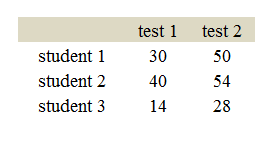Quant
At the end of the term, a group of three students has to take three tests. The maximum score on each test is 200. The table below shows the number of points scored by each of the students on tests 1 and 2.
 Quant
Quant
At the end of the term, a group of three students has to take three tests. The maximum score on each test is 200. The table below shows the number of points scored by each of the students on tests 1 and 2.
[img]https://gmatclub.com/tests-beta/resources/import/img/m25-25.png[/img]
What was the average score of the group of students on test 1?
A. 25 points
B. 28 points
C. 29 points
D. 30 points
E. 32 points
Question Discussion & Explanation
Correct Answer - B - (click and drag your mouse to see the answer)
Verbal
The popular belief that a snake\'s age can be determined by counting the number of layers of scales on its body is generally true. However, to help regulate its internal temperature, the black mamba snake often sheds its outermost layers of scales when the temperature exceeds approximately 120 degrees Fahrenheit, leaving the snake with fewer layers of scales than it would otherwise have. Thus, if a black mamba snake has frequently been exposed to temperatures exceeding 120 degrees Fahrenheit, counting the number of layers of scales on its body will most likely result in an inaccurate calculation of the snake\'s age.
Which of the following is an assumption on which the argument is based?
A) A black mamba snake must be exposed to temperatures above 120 degrees Fahrenheit for several hours before shedding its outermost layers of scales.
B) A black mamba snake will not consistently regenerate the layers of scales it sheds after exposure to high temperatures.
C) All black mamba snakes that have frequently been exposed to temperatures exceeding 120 degrees Fahrenheit have shed at least one layer of scales.
D) Exposure to temperatures exceeding approximately 120 degrees Fahrenheit is the only environmental factor that triggers black mamba snake to shed its outermost layers of scales.
E) The black mamba snake grows no more than two new layers of scales on its body each year.
Question Discussion & Explanation
Correct Answer - B - (click and drag your mouse to see the answer)
Like these questions? Get the GMAT Club CAT’s
What was the average score of the group of students on test 1?
A. 25 points
B. 28 points
C. 29 points
D. 30 points
E. 32 points
Question Discussion & Explanation
Correct Answer - B - (click and drag your mouse to see the answer)
Verbal
The popular belief that a snake's age can be determined by counting the number of layers of scales on its body is generally true. However, to help regulate its internal temperature, the black mamba snake often sheds its outermost layers of scales when the temperature exceeds approximately 120 degrees Fahrenheit, leaving the snake with fewer layers of scales than it would otherwise have. Thus, if a black mamba snake has frequently been exposed to temperatures exceeding 120 degrees Fahrenheit, counting the number of layers of scales on its body will most likely result in an inaccurate calculation of the snake's age.
Which of the following is an assumption on which the argument is based?
A) A black mamba snake must be exposed to temperatures above 120 degrees Fahrenheit for several hours before shedding its outermost layers of scales.
B) A black mamba snake will not consistently regenerate the layers of scales it sheds after exposure to high temperatures.
C) All black mamba snakes that have frequently been exposed to temperatures exceeding 120 degrees Fahrenheit have shed at least one layer of scales.
D) Exposure to temperatures exceeding approximately 120 degrees Fahrenheit is the only environmental factor that triggers black mamba snake to shed its outermost layers of scales.
E) The black mamba snake grows no more than two new layers of scales on its body each year.
Question Discussion & Explanation
Correct Answer - B - (click and drag your mouse to see the answer)
Like these questions? Get the GMAT Club CAT’s
